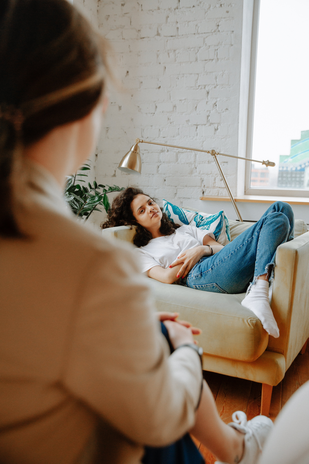What does therapy look like? Laying on a couch facing away from an old man stroking his white beard? Sitting across from a woman on comfy chairs talking with the sounds of the ocean in the background? For Mariah Clare Clark this past year, it looked like texting. Sending blue bubbles and waiting for white ones to appear back.
For Emma Garry, therapy looked like squares on her computer screen. It looked like her childhood bedroom. “It didn’t feel real,” she said.
Teletherapy can be traced back to as early as the 1960s over the telephone, but came into its more modern form in the ‘90s. It can look like text messaging, audio calls, video calls, or a combination of all three. Although teletherapy platforms were born some thirty years ago, their popularity grew immensely during the coronavirus pandemic. And with popularity comes controversy.
Thrust into the spotlight due to the pandemic, like so many other things, is the debate over the effectiveness of teletherapy compared to traditional in-person therapy.
The demand for mental health services like teletherapy is stronger than ever.
“We’ve had over six million people come and take different clinically validated mental health screenings,” said Kelly Davis, associate vice president for peer and youth advocacy at Mental Health America, about MHA’s online mental health screenings during the pandemic. MHA is a national nonprofit dedicated to promoting mental health. The millions of screening results, a big uptick from before the pandemic, show a rise in symptoms of depression, anxiety, and suicidal thoughts.
Clark has struggled with her mental health since middle school. She is in college now, attending classes (virtually of course) and doing what she can to improve herself mentally in a particularly difficult time. She decided to sign up for Talkspace a few months ago, a popular teletherapy platform that allows texting and calling between the client and a licensed therapist. Clark mostly used the text feature.
Talkspace’s website cites results that 80% of its users find the platform “to be as effective or more effective as traditional therapy.” An even higher number of users find Talkspace more convenient.
“It’s good to get things out, but you can’t tell tone in texts,” Clark described. She talked about her ambivalence towards the platform and called it “very impersonal.” She appreciated how easy it was to express herself whenever she wanted in a text to her therapist, but she also described backtracking a lot – re-explaining her situation and feelings because she couldn’t quite capture them right in a message. Texts don’t include body language and facial expressions that a therapist often uses in understanding their clients.
Kristin Ramsey is a private therapist in the DC area who practiced teletherapy last spring as the pandemic began in the United States. She has practiced therapy and art therapy in the pediatric oncology ward of a hospital since 2012. Sent home in March, Ramsey understood how deeply her clients still needed her, so she used a video platform to continue her work.
“Part of what makes being at the hospital manageable was taken away,” she said. Maintaining her relationship with clients and their families was integral to ensuring clients could navigate through the hardship of being vulnerable in a pandemic. One of the things Ramsey’s clients needed most was a space to talk openly with someone. And that space was no longer in the hospital. The pressure was on. “I didn’t think I could,” she said.
Ramsey started teletherapy to use until she could get back in the hospital. She talked about how she viewed her virtual services as still helpful and necessary, although they were simply not the same. Forming relationships with new clients was especially difficult.
“I don’t think you can replace virtually what you get in person,” Ramsey said.
The research on teletherapy is mixed but shows benefits. Text therapy proves to be effective in symptom remission. However, the relationship between the therapist and patient was weaker than one in traditional therapy.
Another study found that online therapy had comparable results to face-to-face therapy for patients with depression. The study even noted that online patients had more positive long-lasting results after treatment.

“The evidence shows that it’s as effective as in-person therapy. I think there’s variations in terms of people’s preferences,” said Davis. She noted that people’s home environments and ability to find a private place to talk are barriers to getting effective teletherapy.
Garry struggles with depression and had clearly mixed feelings as she paused when asked about the effectiveness of her online treatment. She became very lonely at the start of the pandemic, a dangerous combination with her already existing mental hardship.
After being hospitalized in May, Garry enrolled in an inpatient program – one that is usually in a mental health facility. But because of the pandemic, her program was entirely online over video including her personal and group therapy sessions. She sat in front of her computer for hours every day with only some short scheduled breaks.
“It was harder to connect, but I was more open to speak,” she said. Garry found the comfort of her own home helpful in opening up about her mental health during treatment. The familiarity of her environment helped her feel safe.
“People that I know that have done them don’t like them,” Davis said about virtual inpatient programs. She added that there is not much research addressing these programs specifically, and MHA does not know much about them.
“I have found it to be very effective,” said Joy Paul, a private telehealth therapist, on her own teletherapy services. “We see each other in our own home environments.”
Paul found the benefit in online video therapy: seeing her clients act in their own home. She has engaged her clients’ children if they interrupt the session and noticed objects in clients’ video background that became helpful in treatment for anxiety, depression, and other mental health issues.
Paul did have a contingency in her assessment that teletherapy is effective. “I need to see their face,” she said. Texting or audio calls were not going to work.
She stressed the importance of getting therapy at all in this time to “keep in check.” To Paul, the pandemic has brought more concepts to work on in people’s lives from time management to relationships and more.
Clark has since stopped using text-based therapy, although she is glad she used it when she needed to. Now, she focuses on exercise and sleep to maintain her mental health.
Everyone is in different places mentally due to the pandemic. One thing Clark mentioned before waving goodbye on Zoom – “Ask for help.”
Photos: Her Campus Media




